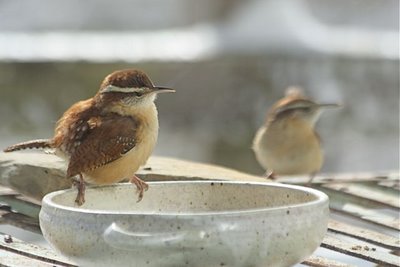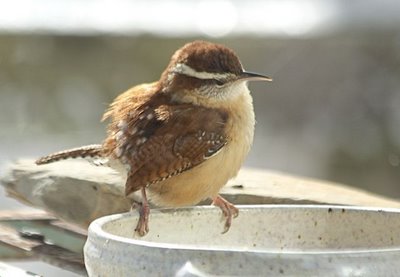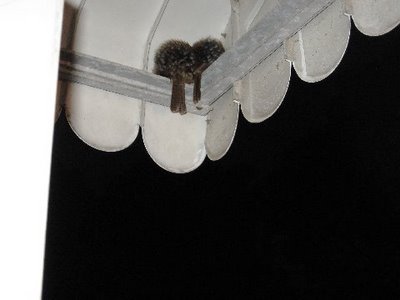During the ice storm of 2009, the sun broke through only intermittently. This photo was taken on a sub-freezing day, when a wren who had come for some Zick Dough suddenly realized how glorious it felt to have sun on his (or her) back. The bird keeled over in a classic sunning pose, its rump feathers lifted and ruffled, as if trying to soak up maximum rays.
 Its mate seems to wonder what's come over it. Honey? You OK?
Its mate seems to wonder what's come over it. Honey? You OK?The wren held this pose for almost a minute, giving me a chance to zoom in on that lovely rump.

The lower back feathers need to be raised and fluffed to reveal the white spangles lying just beneath the brown outer feathers. It really is a lovely effect, but one we all too seldom see. I have seen it, though, on my own porch. At night.
If you saw this on your porch by the light of a flashlight, and you weren't reading a post about Carolina wren rump spangles, would you know what it was?

Neither did the person who sent the picture to my friend Sharon from Maine. Sharon is always getting asked questions about birds. She always knows the answer but likes to check in with the Science Chimp just for fun.
These are roosting Carolina wrens. Awwww. They almost always roost together; they stay as a mated pair year round, and are almost never out of earshot of each other.
My S.C. theory on the rump spangles is that they are meant for camouflage. I'm not sure what they make these sleeping wrens look like, but they don't look much like birds, do they? When I've seen wrens sleeping in the bucket up under my front porch eave, or tucked into a corner in the garage, my first thought is that I'm looking at some kind of small furry mammal. Pretty much the last thing they look like is a defenseless, sleeping bird.
It's not a fully-formed theory, obviously, and I'm open to alternate hypotheses. I just think it's cool to see a small bird utterly transform its shape and appearance while sleeping. And maybe someone out there will look up someday, see a spangly blackish blob up under the porch eave and smile, knowing what it is.






17 comments:
And in a natural, nonwhiteporchroofy world ... say in the crook of an oak branch, they would completely disappear.
I think you nailed it chimp.
Very hedgehoggy.
I've seen a lot of Carolina Wrens but never realized they routinely roosted together like that... awwww!
As far as the theory, how many other wren species have similar spangles, (or are Carolinas the most highly-evolved wrens ;-)?
I've had four wrens roost together that way, on our porch blinds in the summer...all in a row.
You certainly did get some awesome photos! Enjoyed reading about your theory. Makes sense to me!
I love your photos! Check out Wanda's blog! She has a great photo of 4 Carolina Wrens roosting on her porch blinds! wanda-momentsofmine.blogspot.com
See her Miscellaneous post dated Sunday, February 15, 2009. Great photos.
Julie, I had two Carolina Wrens roosting on my front porch for several months. I'm just plain sad that I've seen a female House Finch in that nest lately... But, happy the Wrens are still here.
I've never seen that "hedgehoggy" look! It's very cute.
I love your photographs!!! I want to gain permission to use some of them at a talk I have been asked to give at Daniel Stowe Botanical Gardens on "Inviting Birds to Your Garden". I have long been an avid backyard birder but have never been much of a photographer. Would you please contact me? So many of your pictures illustrate the points I want to make. I couldn't figure out any other way to contact you to ask permission. Thank you in advance.
Hey, littleorangeguy -- I thought the same thing! Hedgehogs with ribbons, or perhaps, bookmarks. I love how their tails look pasted down.
Another swell Science Chimp observation.
They definitely look like 'Spiny Normans'. Clever birds. I wonder, along with cyberthrush, if it is just the Carolinas? Hmmmm.
If you ever need to run things by a third person--one unencumbered by reality--try the Science Chump. I'm the gal for you.
Pine cone impersonation?
Very informative about the wrens.... We have a pair that have taken to our garage overnight(if we leave the door open for them to get in...) and I have wondered where they hide during the night.... I need to adjust what I think I am looking for!!
(I came here via Nina's blog and met Kevin Loughlin personally as he lives close by and was a helper for my oldest's field trip to Cape May to go raptor watching with her teacher Paula...then reading your posts about Guyana....oh, do I have some pennys to save to go on one of his trips....!!! It's on my "bucket list!" In the meantime, I'll join you on your blog... Thanks!!)
I live in South Louisiana and I found 2 of these birds sleeping under the eaves of my house.I wish I could post a picture.
Hi there! I live in North Carolina and went online this morning searching for images of the Carolina Wren sleeping on porch and found your page... I wanted to add that we have a lot of pine cones here, and the speckles make them almost look like a pine cone, when they open up. Just a thought...
I know this is an old post, but I noticed this thing about a week ago now and it has been at my house every evening and gone when I wake every morning. Could it also be a wren?? I don’t see any tail feathers though so I’m at a lost! Thanks!!
If you'd like to send me a photo, @Curious, I'd be happy to ID it for you. Try julieATjuliezickefooseDOTCOM
Post a Comment